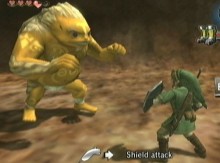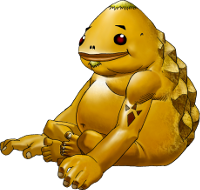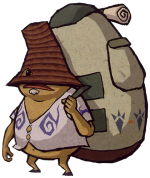The Gorons: Mechanics of Life
Posted on June 07 2013 by Din Akera
 Outlining the biology of Zelda races is an exciting and daunting task. After my previous article regarding the biology of the Gerudo, I have gone deeper into this study and have developed biological theories on the Goron race as well. Gorons have appeared in every Zelda game released after their first appearance in Ocarina of Time — with the exception of Four Swords — and this provides us with a lot of material to examine in attempting to understand the biological make-up of the Goron body, its reproduction, and the evolution of the species. The following are my studies and theories about the biology of the Goron race.
Outlining the biology of Zelda races is an exciting and daunting task. After my previous article regarding the biology of the Gerudo, I have gone deeper into this study and have developed biological theories on the Goron race as well. Gorons have appeared in every Zelda game released after their first appearance in Ocarina of Time — with the exception of Four Swords — and this provides us with a lot of material to examine in attempting to understand the biological make-up of the Goron body, its reproduction, and the evolution of the species. The following are my studies and theories about the biology of the Goron race.
Data Collected
General Description:
Gorons appear to be made of rock and have been consistently referred to as a race of “rock people”. This has been stated by several characters, such as Mayor Bo in Twilight Princess:
Gorons are generally found in mountainous areas, usually situated near a volcano or geothermal heat source. Many appear identical, though there are some exceptions with unique physical traits different from others in their communities. The majority appear to be of average Hylian height, but much broader throughout the arms and core body structure. This size and body structure gives Gorons great physical strength. Their legs are usually quite small in comparison to the rest of their body, and seem to limit walking. Their main mode of transportation, therefore, appears to be curling into a ball and rolling.
Their hard, rock-like exterior appears to be immune to extreme heat but susceptible to water and cold temperatures. The Gorons are known to eat rocks, but it has also been observed that young Gorons will eat Wood Hearts in their early years of life to grow bigger and stronger, as discovered from a young Goron in Phantom Hourglass:
Terminology:
For thorough understanding of the following biological theories, some terminology must first be clarified:
Silica, also known as Sillicon Dioxide, is a crystalline rock usually found in the form of quartz or sand. This substance is extremely hard and used in the production of glass, stoneware, and cement.
Lignin is a compound with similar properties, but is produced in wood from trees and is not as hard as silica. It’s purpose is to provide strength for wood plants such as trees, yet be flexible enough to allow for the bending that occurs during windy days.
Male refers to the member of a species that donates genetic information during reproduction. Female refers to the member of the species that bears the offspring. It’s important to note that these terms do not refer to any elements of an individual’s physical appearance.
Selective Qualities refer to characteristics of a species that cause some survival advantage or disadvantage. This characteristic usually results in the propagation or death of members of the species with that characteristic, which leads to a large presence or absence of the characteristic.
Selective Pressure refers to environmental effects on a species. Changes in the environment will cause strain on the species living in that space. Those individuals most equipped and best adapted to survive under the environmental pressure will survive and propagate those adaptations. This process is most commonly known as “survival of the fittest” or “natural selection”.
Budding is a form of asexual reproduction in living organisms in which new individuals form from outgrowths (aka: buds) on the bodies of mature organisms. The offspring eventually detach from the parent organism when able to support themselves as individuals.
Biological Theories of Survival and Reproduction
The Gorons’ physical make-up is of course a major factor in their ability to survive their environments. Living in heated, high-altitude areas requires incredible heat resistance and minimal dependency on oxygen. Additionally, using rocks as their main source of nutrition requires dependence only on minerals and minimal organic matter. We can assume that the rocks being consumed by Gorons are likely volcanic, metamorphic, and sedimentary based on the location of their homes. These three types of rocks are made up primarily of silica. Gorons, therefore, are actively ingesting this silica compound as their main food resource. Additionally, Gorons are able to move quite easily, speak, and even wrestle. These characteristics — Gorons’ ability to move freely, their nutritional sources, as well as their preferred environment — provide a solid argument against the Gorons’ bodies being made of true rock. Rock does not bend or move without breaking, rocks are too solid to perform gas or nutrient exchange, and volcanic/geothermal environments melt down rocks. It is more plausible however that they are made of an organic, rock-like substance. An example from our world is coral, a sort of organic rock. This type of material is hard, but bendable, very spongy, and most importantly, very porous. A material such as this would allow the Gorons to be hard as rock and quite dense — contributing to their apparent strength — and it would be able to withstand great heat due to its density and porous structure. The pores would allow for air passage for cooling the body when overheated, as well as retain heat in cooler conditions like those of Snowhead in Majora’s Mask.
However, this porous structure would be deadly when combined with water. Not only is a Goron heavy and would sink, but water would easily enter the pores and cause cracks, breakage, and possibly expansion and contraction of the body tissue. All of these would be detrimental to the Gorons’ bodies and would result in severe damage to their inner and outer body structure. Therefore, it is crucial that the Goron bodies are not simply porous rock. They must be porous in structure, but also bendable, like coral. Unfortunately, these theories regarding Goron interaction with water are grey due to insufficient data. Their weakness to water was observed in the alternate dimension of Termina. However, it was later observed to be a non-issue in the Hyrule of Twilight Princess where a Goron is found surviving just fine underwater. Goron body structures may have a weakness to water, but it is also possible they are just unable to breathe and simply drown when they sink. This discrepancy is discussed more in the evolution section.
A porous organic rock composing the Gorons’ body structures would also explain other characteristics observed in the species. These pores would allow for a type of nutrient ingestion; eating silica is not for nutrient exchange — the same process by which we intake nutrients — but only for the purpose of strengthening growing body cells. The organic rock material that comprises the Gorons’ bodies appears to continue to duplicate itself in a similar fashion to the tissue of human bodies; young Gorons grow up into adult Gorons. This means the Goron’s own body cells are growing and duplicating as with most creatures. However, those initial Goron body cells may require strengthening. Fusing with silica compounds would provide strength as well as additional mass. Through intake of this substance the Gorons not only become stronger, but also larger, on top of their natural growth. This would explain why they consume rocks.
The porous structure of the organic rock allows the material to bend and give slightly. However, it is still strong and fused with silica, therefore if bent too sharply it could still crack and break. Spreading the material out over enough surface area, such as a round body, would provide enough distance for the matter to more easily bend. Therefore, Gorons would have to be of a relatively large size to allow the organic rock enough distance to bend and therefore allow the Gorons to move their arms and legs.
Interestingly, young Gorons start off eating Wood Hearts instead of rocks. If we accept that the Goron organic cells fuse with ingested silica for the purpose of strength and growth, then it is very plausible that young Gorons ingest wood products for the purpose of lignin. Like silica, lignin is strong, but unlike the rock compound it is also very flexible. Young Gorons may be too small for their body cells to have enough distance to bend with the hard silica fused to their cells. Until they have enough mass, ingesting silica would cause their bodies to become more rigid due to its extremely hard nature. Lignin from trees would prove to be an effective alternative option, as it is hard but very flexible over shorter distances. It would provide strength and flexibility until the body has grown enough for ensured movement. Switching to silica, the stronger of the two compounds, is then only natural to strengthen the body to its full potential.
It would be interesting to study what point in time Gorons switch from lignin to silica. Perhaps it is simply a matter of achieving a certain body size, or feeling weakening of the cells and searching for something stronger with which to fuse. It may also be possible that adult Gorons look after their children’s diet similar to humans, knowing the signs for when to switch from milk, to soft, to solid foods. However, it is distinctly possible that the Gorons are unaware of the change in their bodies and switching to silica is an involuntary biological action.
Interference with the grown Gorons’ steady diet of volcanic rocks and the silica they contain seems to result in hunger. This was observed when Ganondorf cut off the entrance to the location the rocks are found. The Gorons complained of hunger, yet it may be simply a lack of cell strengthen and cell growth, and only understood as hunger. If the porous portion of the Gorons’ bodies continued to grow, they would require fusion with the silica compounds. Without it, their bodies may become weaker, more susceptible to heat, and even develop small breaks as the cells’ attempt to support their own weight. The body could then express this need as hunger, the same way human bodies express need for nutrients as hunger.
Furthermore, the high altitude and high heat environment constitutes a much less dense atmosphere. Both of these environmental factors would contribute to little oxygen in the air. Living in this environment requires the Gorons to either be extremely efficient at gas exchange — intake of a needed gas such as oxygen, and expulsion of waste gas such as carbon dioxide — or have little to no requirement of oxygen. The latter is much more plausible with the porous make-up of the Goron body. This structure would allow for air passage through the surface of the body and potentially deep into the body cavity. However, an organic rock substance might also have no use for oxygen at all.
Arguably the largest confusion with Goron biology is gender and reproduction. Certain visible aspects of their anatomy provides insight into the type of reproduction most likely used by Gorons: Apparent nipples suggest mammillary glands and belly buttons suggest live birth through placental nutrition in the womb. Combining mammillary reproduction strategies with the body structure of the Gorons suggests females grow a mass of the organic rock material inside or on the body after exchanging genetic information with a male. Once the offspring are able to survive independently they will be “born” or separated from the body of the parent Goron. It is possible that Goron pregnancy and birth do not happen in a womb, but anywhere on or inside the body structure. Because their bodies are made of entirely one substance, it would be possible for young to grow from any portion of the parent body in a similar process to budding. However, as there have been no sightings of one Goron growing off another, internal pregnancy is not out of the question.
Goron societies have shown a lack of females, at least in terms of recognizable human differences between the two genders. There are two plausible explanations for this observation. Firstly, it is very possible that the females are simply not discernible from the males. Many reptiles appear unisexual because their reproductive anatomy is located inside the body cavity and difference in coloration or appearance for distinction between genders is not a required trait in their environment. If this is the case then Gorons simply distinguish gender biologically, with no affect on appearance. The argument against this theory is the use of the Goron phrase “brother”. However, the word is most likely a social element, not a biological statement. A similar example from human societies is the use of the phrase “hey guys” when referring to a group. Females may be present, but the male word is the common conjugation.
Another theory is that females become fertile at a very young age and die after giving birth, thus explaining their absence. This is comparable to the Cavaticus spider, which die shortly after producing a litter of offspring. Baby Gorons would be born male or female but the females will reproduce rather quickly and pass on before being seen by the Hylians. This theory opens up the possibility for Gorons to have litters rather than single births, accounting for the large population. However, this would mean there would be many young Gorons on a regular basis. This is not the case, as young Gorons have only been seen on few occasions.
Asexual reproduction is unlikely. This is partly due to the environment that Gorons live in; harsh climates are known to wipe out species of animals that cannot diversify. Asexual reproduction prevents diversity in a population. However, it’s not out of the question. If the Gorons can produce a bud, as discussed earlier, then the Gorons may produce a cluster of cells on the exterior of their body that would drop off once old enough to survive without the parent body. However, once again, we do not see Gorons walking around attached to each other. This evidence points to mammillary sexual reproduction as the most likely of all theories.
Another interesting observation is the presence of “leader” Gorons in almost all Goron societies. Ocarina of Time introduced us to Darunia, Biggoron, and Medigoron, while Majora’s Mask also presented two giant Gorons, the Goron Elder, and Darmani the hero. Twilight Princess continued the trend with the three Elder Gorons and the patriarch Darbus. The presence of these specific Gorons suggests there are a few different bloodlines within the Goron societies. There are not only leaders, such as Darunia, Darmani, and the various Gor Elders, but also an entirely different line of tremendously large Gorons.
Remarkably, the largest Gorons are not the leaders, though the leaders are somewhat larger than common Gorons. This is an extremely interesting observation. In a society that values strength, it is odd that the largest and strongest would not be the leaders. This observation supports the theory that some sort of bloodline, birthright, or other societal right has put these Gorons into their leadership position. It is possible that Gorons of one bloodline are considered leaders, similar to our society’s view of royal blood. However, there is no proof to support this theory, as we have not seen direct heirs to the leadership position.
Conversely, the much larger Gorons may not be all of the same bloodline, but simply appointed to protector roles (such as Darbus and Hot Rodder Goron) due to their size, or allowed to live out dreams of blacksmithing (Biggoron and Medigoron). There may be no purpose for their large size, other than simple overgrowth. Genetic mutations in other species can cause overgrowth and we may be seeing a similar case with these large Gorons. Regardless, it seems natural for these large Gorons to take roles in their society where their size benefits them.
All species under selective pressures are subject to evolution, and the Gorons are no exception. On the child timeline there is relatively one hundred years between Ocarina of Time and Twilight Princess. For the importance of this study we recognize that it is a significant amount of time but not thousands of years. This duration would have allowed the Gorons to evolve somewhat, but not extensively. We can see a physical change in stature; most “common” Gorons seem to be a slightly larger. We also see anatomical changes to the exterior body, which appears more smooth and with new coloration and markings. These outward changes are our first sign that evolution has occurred in the species. However, the largest change in the Gorons is the ability to withstand water. This trait is observed when Link meets a Goron underwater in the Zora throne room as well as bathing in hot springs on Death Mountain. This adaptation is monumental for the species as it removed their greatest known weakness. To withstand submersion in water with the porous body structure, the Gorons would need to have developed a skin, or skin like covering over their organic rock bodies. Having a sort of skin would prevent water from entering the pores of the rocky substance as well as explain the smoother appearance of these evolved Gorons. This adaptation was also successful for the elder bloodline and the large Goron bloodlines as they also appear in this timeframe.
Additionally, the presence of the Goron underwater is further evidence for the theory that Gorons do not need to breathe. The Goron is now able to withstand the water due to the skin, but is also able to stay under the water’s surface for a significant amount of time. One hundred years would perhaps be enough time for the evolution of a skin, but certainly not enough to lose a reliance on a required substance such as air or oxygen. Therefore the species must not have required air prior to Twilight Princess either.
Through their uninterrupted reign over Death Mountain, the Gorons were able to adapt to its changing environment: The appearance of hot springs and geysers on the mountain. Water in Goron territory was a small enough change to create a selective pressure and allow the Gorons to develop a skin without wiping them out. It should also been noted that it’s possible that only Gorons in the alternate dimension of Termina are sensitive to water, as this weakness is never observed in Hyrule.
Regrettably, the Gorons on the adult timeline were not as fortunate. The great flood was too much of an environmental change for the Gorons to successfully adapt. Many died off and only a few wandering nomads were left in The Wind Waker. It is possible these survivors we able to develop some resistance, perhaps a partial skin, to be able to survive the flood. Interestingly, we see a break down of the Goron society in this timeframe. This is obviously due to a lack of numbers. After some recovery time, the Gorons were able to regroup and reform their regular society in Phantom Hourglass and Spirit Tracks. It would seem that some adaptation was successful by this point, as the Gorons were able to survive in their new environment and begin to rebuild their numbers once again. The genetic mutation of large overgrown Gorons appears to not have been able to adapt fast enough to the changing conditions, as none are found after the great flood. It could also have been simply statistical; the mutation might have been rare enough that the ones who had developed the skin died off by chance. However, a leader still exists in the new Goron society. It would be very interesting to know if this leader is from the same bloodline as the original leaders, or if this leader took the position out of necessity, thus creating an entirely new leader bloodline for the Gorons.
A nomad behavior may be a natural fallback for the Gorons of The Wind Waker as their ancestors were once in a similar position. When the Skyloftian Knight, Link, discovered the surface world, a few Gorons were found in this new place. They appeared to be historians or researchers who traveled around, without the Goron society observed later in the timeline. This behavior also occurs in The Minish Cap when the hero helps several Gorons form a group. It appears to be in a Goron’s nature to wander if not part of an established Goron society. This would make the chance of lone Gorons finding each other much higher than if they usually stayed in one place. This instinctual movement would allow these Gorons to meet and perhaps begin the first society. This instinct took over once again after the great flood and allowed the society to recover to the best of its ability in later games.
Conclusion
Gorons are a very interesting race with a complex biological and social structure. Through careful examination and observation, theories regarding body structure, reproduction, and evolution have developed as described. Gorons are made of a porous organic rock material which fuses with silica to create the “rock-people” we know and love. They appear to reproduce through sexual reproduction similar to mammals, but however have other potential means of creating offspring. The Gorons underwent evolution through both timelines and became stronger in doing so. Further interesting studies of Gorons to look into would include bloodline tracing, reason for water susceptibility, and reason for switching diets from lignin to silica. With the information we have collected, we are able to better understand our beloved Zelda world and make informed arguments in our theorizing. If you have any feedback or information to add to the above study, please leave it in the comments.








